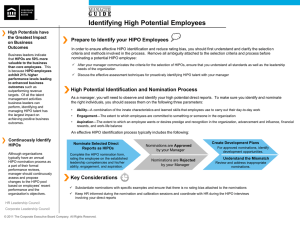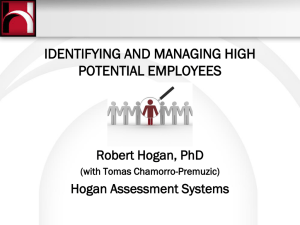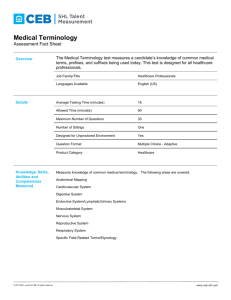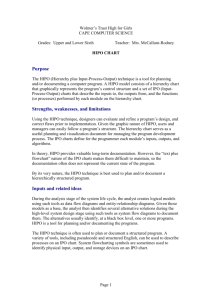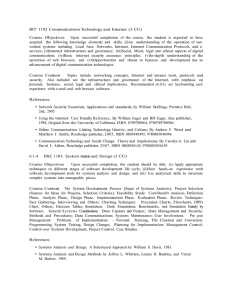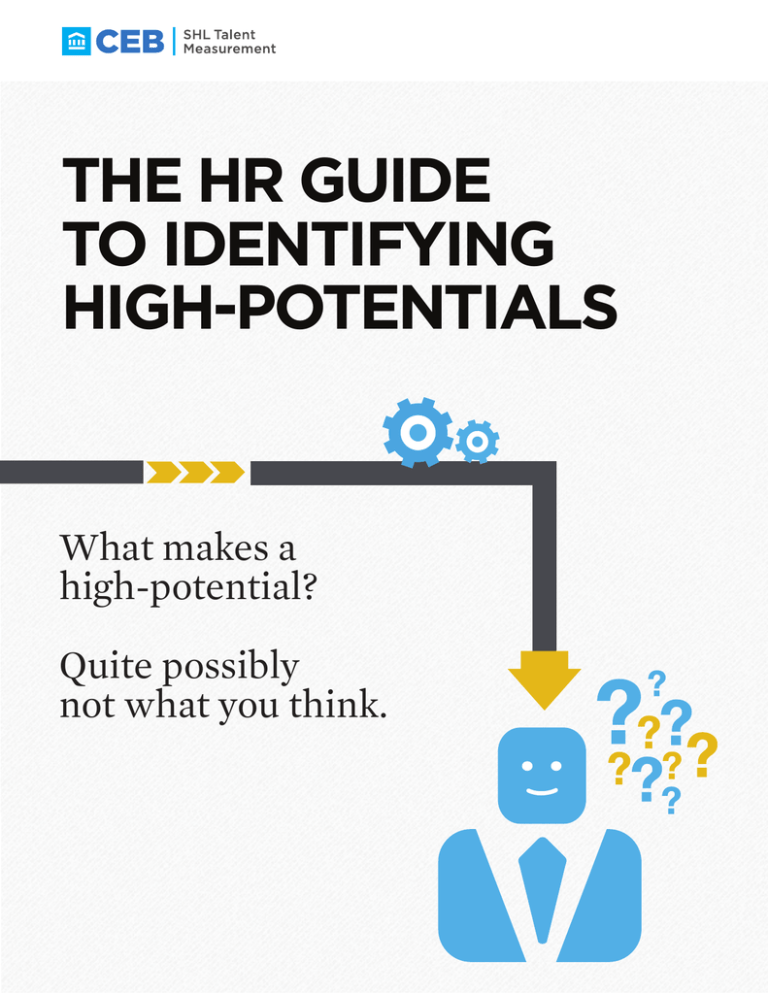
THE HR GUIDE
TO IDENTIFYING
HIGH-POTENTIALS
What makes a
high-potential?
Quite possibly
not what you think.
Want to know more?
Feel free to get
in touch anytime.
Tel: 800-899-7451
www.ceb.shl.com/us/HiPo
The HR Guide to Identifying High-Potentials
Chapter 1 - Introduction
1
If you agree people are
your most valuable asset
then you need to know that
high-potentials (HiPos) are
an even more valuable asset.
In fact, according to our
research a HiPo is twice as
valuable to an organization.
HiPo: WHY THE STAKES ARE SO HIGH
Organizations with stronger leaders can show twice the revenue and
twice the profit growth. Yet a HiPo program, seen by many organizations
worldwide as the feeder to its leaders of the future, is statistically more
likely to fail than succeed – 50% of HR managers lack confidence in their
programs and a staggering 5 in 6 HR managers are dissatisfied with the
results of their programs.
Research covering a decade of assessments and recent analysis using the
CEB analytics database of 6.6m has revealed that:
50%
Want to know more?
OF HR PROFESSIONALS LACK CONFIDENCE
Feel free to get
IN THEIR HiPo PROGRAM
in touch anytime.
Tel: 800-899-7451
www.ceb.shl.com/us/HiPo
REVENUE
2X
PROFIT
REVENUE AND PROFIT GROWTH FOR
ORGANIZATIONS WITH A STRONGER
LEADERSHIP STRENGTH
2
Chapter 1 - Introduction
5 6
OUT
OF
HR PROFESSIONALS ARE DISSATISFIED
WITH THEIR HiPo PROGRAM
The HR Guide to Identifying High-Potentials
55%
WILL DROP OUT OF
THE HiPo PROGRAM
WITHIN 5 YEARS
46%
OF LEADERS FAIL TO MEET
THEIR BUSINESS OBJECTIVES
IN A NEW ROLE
AT LEAST
1 IN 7
Potentially, this means much of your
investment in a HiPo program is at
best wasted and, at worst, feeding
your competitors with some of your
most highly valuable people.
PEOPLE ARE WRONGLY PUT ON
THE PROGRAM IN THE FIRST PLACE
Want to know more?
Feel free to get
in touch anytime.
Tel: 800-899-7451
www.ceb.shl.com/us/HiPo
If you’re reading this guide, chances
are you’re an HR professional who
appreciates that making the right choices throughout your HiPo program is the
key to making it a success.
The first step is to lay a solid foundation and identify the right candidates.
This eBook provides you with revealing and shocking statistics about HiPo
programs, showing why access to the right data is fundamental to making the
right choices. After all, it will provide a talent pool of future business leaders,
with the capacity to run your organization.
The HR Guide to Identifying High-Potentials
Chapter 1 - Introduction
3
Whether you are still exploring the idea of introducing a HiPo program to
your organization and want to understand how you can identify the right
candidates, or you are looking to optimize your HiPo identification process,
this eBook can serve as your helpful guide.
By establishing how to identify your true high-potentials and how to run a
successful HiPo identification program, this eBook will take you through the
steps you need to know. This guide will take you through solving potential
problems and understanding the important role HR has to play in the success
of identifying HiPos.
It will also outline how HR can start to reframe the HiPo conversation with
senior management and introduce data-driven identification, as the first step
to turn intentions into actions.
High-potential versus high
performance – why the
difference matters.
Did you know that only one
in seven high performers
are actually high-potential
employees?
Want to know more?
Feel free to get
in touch anytime.
Tel: 800-899-7451
www.ceb.shl.com/us/HiPo
It’s true. So why then do many organizations still make the wrong
assumption – that a high performer is also a high-potential? One of the
problems is that managers are putting forward staff for a HiPo program
without having a robust identification process in place. As a result candidates
are being nominated for subjective reasons and not scientific reasons.
But it doesn’t have to be this way. HR managers can now have access to the
tools and information that can transform the identification stage of HiPo
4
Chapter 2 - High-Potential Versus High Performance
The HR Guide to Identifying High-Potentials
programs. This will ensure the program is worthy of its investment, creates
competitive advantage and produces a source of future leaders – but to
achieve this you need a proven systematic approach.
ARE YOU NOMINATING FOR THE RIGHT REASONS?
“
In some cases HiPos are not being selected with valid or structured reasoning
in mind. While selecting individuals on the basis of high performance isn’t
unheard of, in the worst case selection can be simply based on:
It’s your turn. You’ve been here long
enough, you’ve done a reasonable job, so
we’re going to put you on the program.
If you consider that only 1 in 3 organizations are using hard assessment data
to identify their potential, it’s not surprising the nomination process can be
unclear.
“
Without a clear set of criteria, why would you be surprised a program fails? To
quote Albert Einstein:
Insanity: doing the same thing over and
over again and expecting different results.
If you carry on doing the same thing, why would you expect anything to
change?
TYPICAL ISSUES YOU’LL UNCOVER WHEN A HiPo PROGRAM STARTS
TO GO WRONG
Want to know more?
Feel free to get
in touch anytime.
Tel: 800-899-7451
www.ceb.shl.com/us/HiPo
The problems caused when a HiPo Program starts to go wrong don’t just
affect HR or the employees on the program. It spreads right through the
organization.
Here are some issues being discussed by HR managers and colleagues that
might sound familiar in organizations where the HiPo program is failing to
deliver:
•
Business leaders and HR are unconvinced that the right people are going
on the program but they have no structured answer to the issue
The HR Guide to Identifying High-Potentials
Chapter 2 - High-Potential Versus High Performance
5
•
The HR manager or line manager is not convinced the existing program is
producing the goods
•
A lot of people simply don’t make it through the program
•
Individual performance isn’t meeting business objectives and some HiPos
are unable to work at the level and pace that the assignment requires
•
People identified as HiPos are leaving the organization
•
People are being identified as HiPos with highly subjective information e.g.
preferences of managers or based on tenure with the organization
HOW DO YOU IDENTIFY THE RIGHT CANDIDATES FOR YOUR HiPo PROGRAM
– IT’S TIME TO INTRODUCE YOU TO THE THREE COMPONENTS
It’s about understanding your employees better. What you really need to
know is:
•
•
•
The risk that candidates will fail to achieve a senior position.
The risk you don’t produce the quality of employee who will be effective in
a more senior role
The risk of diluting your benchstrength through people leaving and going
to the competition
In-depth analysis and research has clearly highlighted three major
components that highly correlate to identifying the right candidates:
•
•
•
Aspiration
Ability
Engagement
These three components have proven to be robust in identifying true HiPos whether you’re in the banking sector in Hong Kong or in retail in New York.
Want to know more?
Feel free to get
in touch anytime.
By assessing the ability, aspiration and engagement of your HiPos, it makes
your odds of success much greater. By looking at these three components you
have a structured, scalable and practical framework for your selection process.
Tel: 800-899-7451
www.ceb.shl.com/us/HiPo
6
Chapter 2 - High-Potential Versus High Performance
The HR Guide to Identifying High-Potentials
IDENTIFYING HIPOS : THE THREE COMPONENTS
EXPLORED
10 years of data shows there is a way to choose
the right HiPo.
ASPIRATION
ENGAGEMENT
HiPo
1. Aspiration- To rise to senior roles
2. Ability- To be effective in more responsible and
senior roles
3. Engagement- To commit to the organization
and remain in challenging roles
ABILITY
Want to know more?
Feel free to get
in touch anytime.
Tel: 800-899-7451
www.ceb.shl.com/us/HiPo
“
A HiPo employee is a proven high performer with
three distinguishing attributes that allow them to
rise and succeed in more senior, critical positions:
Remember this statistic? Only one in seven high
performers is a HiPo. So while high performance is
a starting point for identifying candidates, you then
need to assess these individuals for their aspiration,
ability and engagement to establish who is a HiPo:
•
Assess for aspiration and critical career management behaviors to
understand if an employee will rise to a senior and more challenging
position and turn that motivation into career success
•
Assess for future managerial and leadership ability to know whether the
employee has the competencies required for success in more senior and
challenging roles
•
Evaluate engagement to know whether the employee is committed to the
organization and sees the organization as the best place to realize their
career goals
DOES YOUR HiPo HAVE THE ASPIRATION TO BE A HiPo?
After analyzing 18 motivational factors it was these six that were found to
drive the achievement of an executive position:
Does the employee have the motivational profile to
reach a senior position and the behavioral profile to
turn that motivation into tangible career success?
•
Immersion: they look for roles that require a personal commitment above
the norm
The HR Guide to Identifying High-Potentials
Chapter 2 - High-Potential Versus High Performance
7
•
Activity: they prefer fast-paced, multi-tasking work environments
•
Power: they want the opportunity to exercise, influence and shape how
things are done
•
Interest: they look for roles and assignments that provide variety and
stimulation
•
Flexibility: they seek out work environments that allow them more fluid
ways of working
•
Autonomy: they are attracted to roles that allow them autonomy in how
they execute their responsibilities.
These motivations contribute to aspiration when the employee also exhibits
the following behaviors:
MOTIVATION
BEHAVIOR
THE ACTIONS THAT
THE INHERENT DRIVERS
INDIVIDUALS
THAT FUEL SUCCESS
TAKE THAT PROMOTE
THE LIKELIHOOD OF
ACHIEVING A SENIOR
POSITION
CAREER SUCCESS
•
Using Initiative & Taking Responsibility: they are willing to take
calculated risks to realize an opportunity and assume positions of
responsibility through which they can coordinate and impact on tasks,
projects and objectives.
•
Achieving Objectives & Pursuing Self-Development: they push for
results and are willing to invest in their personal development.
Want to know more?
Feel free to get
in touch anytime.
Tel: 800-899-7451
www.ceb.shl.com/us/HiPo
CHANGE IN THE ODDS OF SUCCESS
Our analysis shows that these behavioral markers combined with the six
critical motivational drivers increase the odds of achieving an executive
position dramatically – by a factor of 11.
12
10.6X
8
4.1X
4
1X
2X
0
Q1
(LOWEST QUARTILE)
Q2
Q3
Q4
(HIGHEST QUARTILE)
MOTIVATION + BEHAVIORS (OVERALL METRIC)
8
Chapter 2 - High-Potential Versus High Performance
The HR Guide to Identifying High-Potentials
WHY ABILITY IS ONE OF THE IMPORTANT COMPONENTS
To fully understand this factor a clear definition of the attributes for someone’s
potential to be an effective manager and leader is required. Effective
managers and leaders know how to:
•
DEVELOP a compelling vision that is based on clear and critical thinking.
•
ARTICULATE and communicate goals that motivate others and provide
direction.
•
COMMUNICATE effectively and support others through change.
•
GET THINGS DONE and realize tangible goals and objectives.
These talents are both the transactional (managerial) and the transformational
(leadership) roles required of leaders and managers to ensure that
organizations have direction, share common objectives, collaborate to achieve
and, finally, deliver their strategic goals.
The diagram below shows why you need a deeper understanding of ability.
Organizations often target early career professionals with 10 years or less
experience for their HiPo programs. However, at this stage of their careers, the
spread of ability is often ranked at very-low to low levels of overall leadership
potential, while only 1 in 4 rank at the high to very high levels.
It’s important, therefore, to identify the 1 in 4 within your organization.
1 IN 2
40
1 IN 4
PERCENTAGE
30
20
Want to know more?
Feel free to get
in touch anytime.
10
Tel: 800-899-7451
www.ceb.shl.com/us/HiPo
0
VERY LOW
LOW
MODERATE
HIGH
VERY HIGH
SHL TALENT MEASUREMENT SOLUTIONS LEADERSHIP BENCHMARK
ALL PROFESSIONALS WITH 10 YEARS OR LESS EXPERIENCE
The HR Guide to Identifying High-Potentials
Chapter 2 - High-Potential Versus High Performance
9
Nurturing lower scoring candidates for more specialist roles becomes a second
plan of learning and development for the HR team. Here the HiPo program
is informing potential but re-routing the candidate for training and further
consideration in the future.
WHO HAS THE ENGAGEMENT? THE THIRD ESSENTIAL COMPONENT
It’s all very well that your candidates are high performers, they are full of
aspiration and they demonstrate ability, but what next?
HiPos with low engagement are prone to flight from the organization. And
a staggering 55% will drop out of the HiPo program. You need to qualify
engagement. Engagement is the strongest indicator that a HiPo will stay with
the organization.
HIGH
ABILITY
THE NOT-SO HIDDEN RISKS OF LOW
ENGAGEMENT
Lacks
Aspiration
LOW
Engagement
‘Who will stay?’
HIGH
ASPIRATION
Higher Risk
Lower Return
Lacks
Ability
So now who wants to go and see the CEO
and tell them that half of the top talent in the
company is likely to leave within 5 years?
Now you know about it, you can take the lead
and do something about it.
in touch anytime.
Tel: 800-899-7451
www.ceb.shl.com/us/HiPo
60
60
50
50
PERCENTAGE
Feel free to get
PERCENTAGE
LOW
Want to know more?
By contrast, nearly 60% of high-potential
employees with high engagement levels have a
high intent to stay – more than double that of
high-potential employees with lower levels of
engagement.
40
30
20
10
0
40
30
23%
20
10
Q4
2009
Q4
2010
Q4
2011
Q4
2012
Q4
2013
EMPLOYEES WITH HIGH INTENT TO STAY
10
59%
Chapter 2 - High-Potential Versus High Performance
0
LOW ENGAGEMENT HIGH ENGAGEMENT
HiPos
HiPos
EMPLOYEES WITH HIGH INTENT TO STAY
The HR Guide to Identifying High-Potentials
Employee engagement is a concept that is widely accepted but loosely
defined. An employee’s engagement is composed of two factors:
•
Current Engagement, which is determined by a combination of past
experiences with an employer (positive or negative) and their current
experiences in their job, role and work environment
•
Future Engagement, which is determined by their future expectations
about their job, career and their employer, or what CEB calls Engagement
Capital.
CURRENT ENGAGEMENT
HR needs to be an equal business partner in the day-to-day management
of HiPo programs. Every day the experiences, interactions with other staff
and managers, the types of work and challenges that are set and the
cultural impact of organizational goals and ethics, is making or breaking the
engagement of the HiPo candidate.
An employee is more likely to have strong current engagement when their
past and current work fit their work preferences. Likewise, employees are
more likely to have future engagement when their organization’s mission,
direction and values are aligned with their beliefs.
ENGAGEMENT CAPITAL
TALENT OUTCOMES
CURRENT CAPITAL
Employees; emotional and rational
commitment based on their perception
of past and present experiences
FUTURE ENGAGEMENT
Want to know more?
Feel free to get
in touch anytime.
Employees; emotional and rational
commitment based on their expectations
of their future employment experience
Discretionary Effort
& Performance
Intent to Stay
Retention
Tel: 800-899-7451
www.ceb.shl.com/us/HiPo
The HR Guide to Identifying High-Potentials
Chapter 2 - High-Potential Versus High Performance
11
WHAT ARE YOUR PLANS FOR YOUR HiPo’s FUTURE? HOW DOES THIS MAP
TO ENGAGEMENT?
HiPos are in demand. Yes you want them, but then so does everyone else –
including your competitors!
So how the future looks and feels to the HiPo is important. They are going to
be as interested in their alignment with the organization’s mission and goals
as they are with their own personal challenges and goals.
Identifying high-potential candidates with future engagement increases
the likelihood that they will be engaged when placed in more challenging,
complex and taxing senior roles. It also avoids the costs of losing the
candidate – remember the 55% that will likely leave or drop out of the
program if you’re identifying the wrong people.
INTRODUCE STRETCH ROLES TO ENGAGE AND RECOGNIZE
YOUR HiPos
Now you’re going to say “Hang on, 46% of HiPos fail in a new role.”
Right?
Yes, but that was also when you had the wrong people in the program. Right?
The most effective high-potential programs, with the right people, are
centered on very visible, important and challenging stretch roles. These roles
place individuals in assignments where their potential can be applied and
realized and they drive up organizational commitment and reduce the risk of
attrition.
But you need to put in place the right support structure around the HiPo to
protect them - detecting failure and supporting them when it happens. This
means engaging with line of business, not just in the performance part of the
role but also with a clear structure in the planned management of the role.
Want to know more?
Feel free to get
in touch anytime.
Tel: 800-899-7451
www.ceb.shl.com/us/HiPo
12
Stretched roles have impact when they:
•
Reinforce aspiration by talking to the key motivations that drive career
success, and when they build and reinforce the behaviors that translate
motivation into tangible career success
Chapter 2 - High-Potential Versus High Performance
The HR Guide to Identifying High-Potentials
•
Reinforce ability by targeting key skills and competencies that drive
competitive advantage for the organization and are seen to develop the
employee and promote the longer-term success of the organization
•
Reinforce engagement by demonstrating that staying with the
organization is in the employee’s best interests; it promotes career
success, matches development opportunities to personal career goals,
and mitigates the potential for failure that comes with high-risk and highreturn assignments.
High-potentials seek and value stretch assignments – and love the recognition
it brings.
The CFO has a question for
you
“
Typically the person asking the difficult question is the CFO. They want to
know:
If I put all this money into these programs today, how do
I know I’m going to get a return on them in the future?
It’s an issue for the HR manager and the CHRO, and this is where our model
adds value through its logic, practical application and the data that addresses
the key risks to your HiPo program.
Everyone would agree that we need effective managers and leaders today and
in the future - that is simple common sense.
What your CFO might not know is that those organizations with stronger
leadership benchstrength show up to two times the revenue and profit growth
of organizations with weaker benchstrength.
Want to know more?
Feel free to get
in touch anytime.
Tel: 800-899-7451
www.ceb.shl.com/us/HiPo
So, that’s the ROI issue - if we can identify, develop and retain high-potential
employees, then that’s one factor that is clearly going to drive future
organizational performance. Few would argue with that.
Now here comes the power of the model. Any CFO will know that an
investment carries risk, and your CFO might know the stats
The HR Guide to Identifying High-Potentials
Chapter 3 - The CFO has a question for you
13
we have shown about the likely success of HiPo programs as they are run
today. But, you know the key risks and how they can be addressed.
So, here’s how your conversation with the CFO could start…
“
Okay, we’ve identified these three risks to our programs. These
are the actions we’re taking, so back to that money you’re
investing in the program, here is what we’re doing. We can’t give
you an ROI today, but what we can show you, in a systematic way,
is how we’re managing the risks to failure of these programs. In
particular we’ll explain how we’re going to tighten the program
up to make sure we get the right people on it.
DOES HR HAVE AN IMPORTANT ROLE TO PLAY IN KEEPING HiPos FROM
LEAVING, OR STOPPING THEM FROM DROWNING?
The short answer is yes. But let’s look in more detail.
First of all, there is a significant role for HR in supporting the line manager.
The line manager is a critical factor for the overall success. If you’re a HiPo
who is happy with your boss, you see your boss as someone who will support
your development, who is there to encourage your success, who will enable
you to achieve your career goals. As a result you are much more likely to
bind to the organization because you are more likely to be engaged with the
organization today and tomorrow.
HR mustn’t fail to give managers the route map that helps them support
HiPos. The strong organizations are the ones where HR is working with the
managers so the managers can have a very focused, structured conversation
with the candidate, and they can agree what’s going to happen next.
Want to know more?
Secondly HR also has a responsibility to engage senior management, going
back to the C-suite and the CFO by making sure they’ve got the right kind of
day-to-day structure in place to manage those programs effectively.
Feel free to get
in touch anytime.
Tel: 800-899-7451
www.ceb.shl.com/us/HiPo
14
Chapter 3 - The CFO has a question for you
The HR Guide to Identifying High-Potentials
It’s about ensuring they have confidence in the program and knowing they can
answer all the fundamental questions:
•
Are you putting the right people on the program?
•
Do they have a clear set of priorities for learning and development?
•
Why are we investing in this development spend for these people?
WHAT IS THE IMPACT OF GOOD HR?
When you compare your people to your competitors, either globally or locally,
can you identify any gaps? By investing in the gaps you can lift the bench
strength and improve your competitiveness in the marketplace. These are
elements at the micro and the macro level that good HR has a really big
impact on.
Part of that is supporting the manager, but part of that also is having the right
kind of data to give you an overview and give information back to the C-suite
to show:
•
•
•
•
That the right people are going on the program
How they are being tracked through the program
How we manage the attrition rate
How we manage the leaving rate
Also, line manager feedback is important in terms of the satisfaction when
they’re receiving candidates into their teams. Find out what the data is saying.
When HiPos step into these leadership roles, are they perceived to be stronger,
more able? That’s the other key function that HR should be performing.
Maybe you find you need to step away from the ‘labels’ often attached to HiPo
programs and focus more on the operational processes and having the right
kind of data to answer the right kind of questions, and be proactive.
Want to know more?
Feel free to get
in touch anytime.
Tel: 800-899-7451
www.ceb.shl.com/us/HiPo
The HR Guide to Identifying High-Potentials
Chapter 3 - The CFO has a question for you
15
HiPo IDENTIFICATION: THE HR MANAGER’S TO DO LIST
Ok, so what are the next steps?
Imagine you’re responsible for the performance of the HiPo program
(assuming you’re not already). You’re building the leadership bench and
creating the competitive advantage you need for the future. You’re giving the
organization the best chance to achieve revenue and profit growth and avoid
the mistakes of ordinary companies who let talent slip away.
Want to know more?
•
Get high performance as the sole criteria for consideration off the
agenda! Do it now
•
Create a plan to review every candidate on the HiPo program and reassess each candidate
•
Carry out a talent audit on your existing candidates and extend the
audit to other high performers to check you didn’t miss anyone (especially
if you suspect you’re using subjective criteria)
•
Establish a feedback mechanism with your line of business and get
these business leaders ready to offer support and develop stretch roles
•
Communicate clearly with managers. Outline challenges they may face
with HiPos already in their teams, and those that are coming their way
•
Go to the CEO and the CFO armed with all the statistics about HiPos
and explain that you’re going to carry out a comprehensive review based
not only on high performance, but also ability, aspiration and engagement
•
Explain that you’re going to create a data-driven robust process to
identify your HiPos
•
Use the new analysis from your talent audit to create new understanding
about those people on the HiPo program today, and who should actually be
on the program
Feel free to get
in touch anytime.
Tel: 800-899-7451
www.ceb.shl.com/us/HiPo
16
Chapter 3 - The CFO has a question for you
The HR Guide to Identifying High-Potentials
Improve your odds of
success. Remember the
stakes are high.
HiPo programs are not delivering. You may have known that
already, but you certainly know the statistics now.
Those statistics don’t need to be the ones you experience with
your programs. Our model and our tools, based on working with
leading organizations worldwide, will change the odds in favor of the
success for your programs.
Having clear, objective data that tells you whether your candidates
have the aspiration, ability and engagement to drive the success of
your programs will put you and your organization in control of those
odds.
Want to know more?
Feel free to get
in touch anytime.
Tel: 800-899-7451
www.ceb.shl.com/us/HiPo
The HR Guide to Identifying High-Potentials
Chapter 3 - The CFO has a question for you
17
Want to know more?
Feel free to get
in touch anytime.
Tel: 800-899-7451
www.shl.com/us/hipo
©2014 SHL, a part of CEB. All rights reserved.

